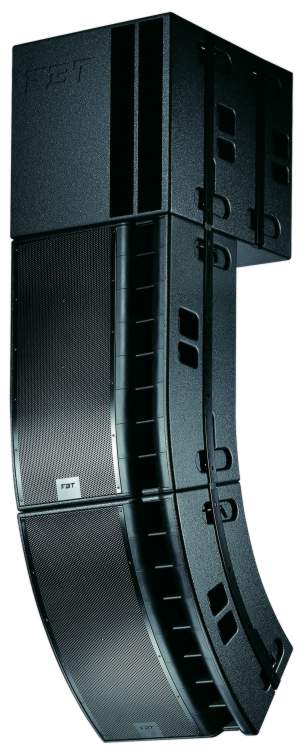| Pro-Music-News™ | Pro Audio |
| Index Pro Audio | Main Index English | Search Site |
FBT introduces self-powered Modus line-array at pl+s and at InfoComm 2008
| Following the debut of FBT’s Modus passive line array systems in 2005, FBT expands the Modus range with self-contained line array speakers incorporating four modules in a vertical array within a single enclosure no larger than a traditional 2-way speaker. Producing vertical and horizontal dispersion patterns already optimised to effectively meet a broad range of sound reinforcement requirements, the new powered Modus models are suitable for small and medium touring applications as well as for fixed installations.The self-powered Modus were introduced at prolight + sound show 2008 in Frankfurt, at InfoComm 2008, Las Vegas, and will also be highlighted at PLASA 2008, in London, stand M48. The system is comprises of two line-array enclosures, Modus 15 and Modus 40, plus the band-pass subwoofer Modus SUB. The whole system can be easily flown thanks to the user friendly built-in hardware. The two array models offer coverage patterns of 90°H x 40°V and 90°H x 15°V dispersion angles, which can be used alone or in pairs to form a “J” array capable of covering a 90°H x 55°V angle. The Modus Sub can either be suspended or stacked to provide extended low frequency power when required. A full range of accessories allow eight different configurations (4 flying and 4 stage set-ups). The self-powered Modus models are equipped with 3 x 700W rms brand new Class D amplifier modules with convection cooling and a digital signal processor providing seven unique user-friendly equalization presets whilst managing a built-in delay line up to 63.75m in steps of 25cm. Modus 40a and 15a both feature powers of 1400W (LF) plus 700W (HF) to reach up to 137 dB SPL with a 2-way, true line-array bi-amplified system in bass-reflex design. The low frequency section contains eight 8” (2” VC) custom neodymium woofers, the high frequencies are covered by eight 1” (1.7” VC) custom neodymium compression drivers coupled to a waveguide with 90°H dispersion horn. Coverage angles are 15° vertically for Modus 15a and 40° vertically for Modus 40a. Extended frequency response to 58Hz allows mid SPL applications without subwoofer. The digital signal processor provides cross-over, delay, energy control, dynamic low frequency equalization, frequency domain equalization, on-board equalization presets, digital delay line set up to 63.75m in steps of 25cm, and 24bit 192KHz very low noise A/D and D/A converters. The control panel offers XLR input and link, two dipswitch sets to control delay and choice of presets, a dipswitch to allow high-pass filter insert when used with subwoofer, ground-Lift, limiter and protection LEDs. Enclosures are made of 13-layer birch plywood extra textures scratch resistant enclosure (18mm / 0.71”) with integrated handles and hardware for suspension offering a 10:1 safety factor. An optional wheel trolley to house one Modus 15a/15 or a MODUS 40a/40 is available for easy transport. Power supply through Neutrik Powercon input and output connectors for power linking between cabinets avoids extra power cables. The Modus SUBa subwoofer in band-pass configuration delivers up to 140 dB SPL at an extended frequency response down to 38Hz. The particular type of acoustic load allows drastic reduction of distortion and free excursion of the woofer cone for high reliability. Two 15” (4” VC) B&C custom neodymium drivers in push-pull configuration are driven by the 1400W rms Class D (PWM) high efficiency amplifier. DSP provides cross-over, delay, energy control, dynamic low frequency equalization, frequency domain equalization and on-board equalizer presets for variable volume control in 3dB steps to match output of satellite systems The digital delay line offers up to 63.75m in steps of 25cm. It featiures the same converters and control panel as the full range models. Modus SUBa/SUB can be suspended or ground-stacked with Modus 15a/15 or 40a/40, Four optional castors and an optional wheel trolley facilitate quick and easy transport. |
 |